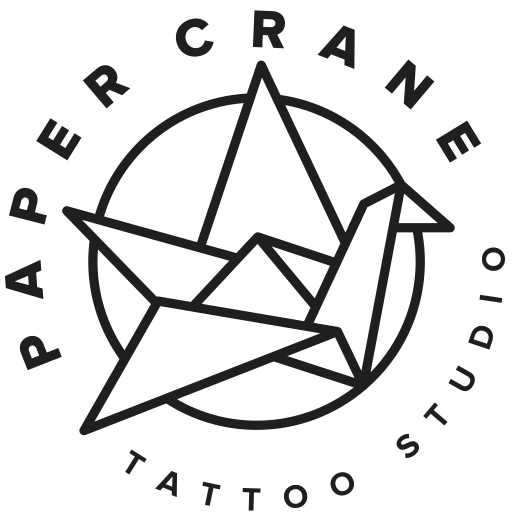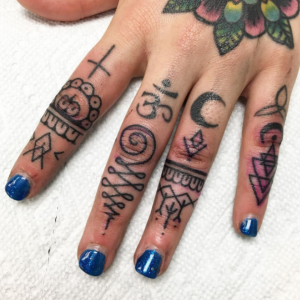Too Taboo to Tattoo? Hand, Neck, and Face Tattoos in the Modern World
At Paper Crane, we're all about self-expression—and we're here to help you feel like your most authentic self through tattoos that reflect your unique personality. When it comes to extreme body modifications (whether for other industry professionals or our clients), we fully support your vision.
The fact is that you'll find few places as accepting of extreme body modification as a tattoo shop. Although the outside world has come a long way—your local barista can proudly show their ink now!—we still live in a society where certain types of tattoos are given a sideways stare.
Today we're taking a look at hand, neck, and face tattoos to get an idea of why they carry certain negative connotations, how they've evolved over the years, and whether one of these taboo tattoos is right for you.
Cultural Perspectives on Tattooing
Across the world and throughout history, tattoos have held many meanings—symbols sacred or profane, markers of privilege or of servitude, an ancestral tradition or a way to stand out from the crowd.
Ancient Rome serves as an excellent example of the rich, often contradictory meanings tattoos can embody. Slaves and convicts were often branded or tattooed on the forehead to mark their status. Roman soldiers also received tattoos—but the ink on their hands was a badge of honor, one that signified the completion of their training. In later years, certain Christian groups came to adopt the forehead tattoos that had previously been considered a stigma.
But despite (or perhaps because of) the efforts of the extremist Christians of late antiquity, most of the modern world has yet to embrace facial tattoos. The same goes for neck and hand tattoos: In the US and many other countries, ink on the hands, face, or neck is considered a sign of gang affiliation or prison time. For example, ask anyone—tattooed or not—what they think a teardrop tattoo means: Chances are they'll say it's a sign the person has killed someone, done hard time, or lost a fellow gang member.
In Japan, it's not uncommon to see “no tattoos allowed” signs at pools, gyms, and other public places, due to their association with the yakuza. “I was discriminated against most in Japan,” our founder Mikey Vigilante recollects. “As rich a the history and art of tattooing is in Japan, the Japanese do not like to see tattoos. You will be politely discriminated against.”
Although the US is decidedly more tolerant of tattoos, ink on your hands, face, and neck can still make you a target of discrimination. Take the military: Although it has relaxed its tattoo policy to some extent (sleeve tattoos are now allowed in the Army, for example), hand, neck, and face tattoos are still prohibited (with the exception of one ring tattoo per hand).
And it's not just government jobs that don't go for these placements: Starbucks finally realized that no one cares if their baristas have tattoos, but they still don't allow employees to have tattoos on the face or throat. Many organizations have a similar policy, often adding hand tattoos to the list.
But in both ancient and modern times, there are some cultures that fully embrace tattoos on every inch of the body—and facial tattoos are among those particularly revered by certain peoples. In Africa, the women of the Peul and Fulani tribes of Mali get facial tattoos to celebrate adulthood, beauty, and marriage. The Ayatal tribe in Taiwan similarly still practices facial tattoos (for both men and women) as a sign of maturity.
“Pacific Islanders are very enthusiastic about tattoos,” Mikey observes, and it's an enthusiasm that continues to thrive: The Maori moko is arguably the most famous example of facial tattoos, both traditionally and today. Maori men and women alike to this day receive “Ta moko” as a rite of passage into adulthood. Carved rather than inked with a needle, the moko can be found on both the body and face—but the fearsome warrior with a heavily inked face is typically what we think of when we hear the word “moko.” Far from being a stigma, the moko was traditionally a marker of a high social status, and it is now a way of proudly expressing cultural heritage.
Changing Times for Tattoo Enthusiasts
While the Pacific Islanders have always been cool about tattoos, the rest of the world is just starting to adopt a more tolerant (and at times accepting) attitude when it comes to hand, face, and neck placement. As mentioned already, once upon a time you would not have seen a bit of ink on your Starbucks barista. Today, though, it's not a shock to see a hand tattoo on the nurse taking your blood sample. “Lawyers and professors also tend to be able to get away with more visible tattoos,” Mikey has noticed. “It's often the more successful independents that can get blasted and still pursue their careers. The employed tend to have a harder time because of antiquated company policies.”
But as companies begin to shift their policies, our artists are getting a lot more requests for hand tattoos in particular. Neck and face tattoos continue to be more of a rarity, but we still get the opportunity to do these pieces on occasion. Typically with all of these placements, our clients tend to have an existing tattoo collection. “Sometimes we'll get a brazen eighteen year old asking for a tattoo in a highly visible spot,” Mikey notes. “But I've found that typically it's either the young-and-rebellious or the middle-aged-and-over-it crowd.”
Interestingly—but perhaps not surprisingly—the majority of people getting these tattoos are in the tattoo industry themselves. “I don’t have my face or neck tattooed, so it's hard for me to talk about that kind of discrimination,” Mikey tells us. “But I do have my hands and fingers blasted. I tend not to give a enough fucks to notice any intolerance, though. I think people find it interesting, actually, when a tattooed, successful, articulate, and sociable person is communicating with them. The tattoos become mystic because the stigma of tattoos and the derelict expectation are both crushed.”
As artists and individuals, we're all about crushing stigmas and negative expectations—and we're proud to say that we've got tattooed clients, family, and friends who do exactly that every day.
Your Body, Your Call
It's true that some artists will refuse to do certain tattoos. Finger tattoos in particular have become so mainstream that you most likely won't have a problem there, but the career-ruining potential of neck and face tattoos may make the occasional artist understandably uncomfortable.
As for Mikey, he doesn't typically refuse, unless a tattoo isn't a good fit for him aesthetically. “I will advise, though,” he adds. “It's not my place to make decisions for clients, but my dad-self still needs to say some words based on my experience and wisdom.”
So what words would Mikey give to those thinking of a face, neck, or hand tattoo? “These tattoos are not for the faint of heart,” he wants you to know. “They will make getting a job more difficult. You are about to enter a world of self-reliance. People will hate and will judge. You will have to be better than them—or you will get crushed.”
With those words of wisdom in mind, we invite you to reach out to us if you want to talk more with Mikey or any of our artists about the pros and cons of these particular tattoo placements. If you decide a hand, neck, or face tattoo is for you, we'd be happy to work with you to design a custom piece.
Already have one of these taboo tattoos? We'd love to know your story! Tell us about any triumphs, difficulties, or surprising moments that you've had sporting your highly visible ink by dropping us a note at info@papercranetattoo.com. We look forward to hearing from you!


